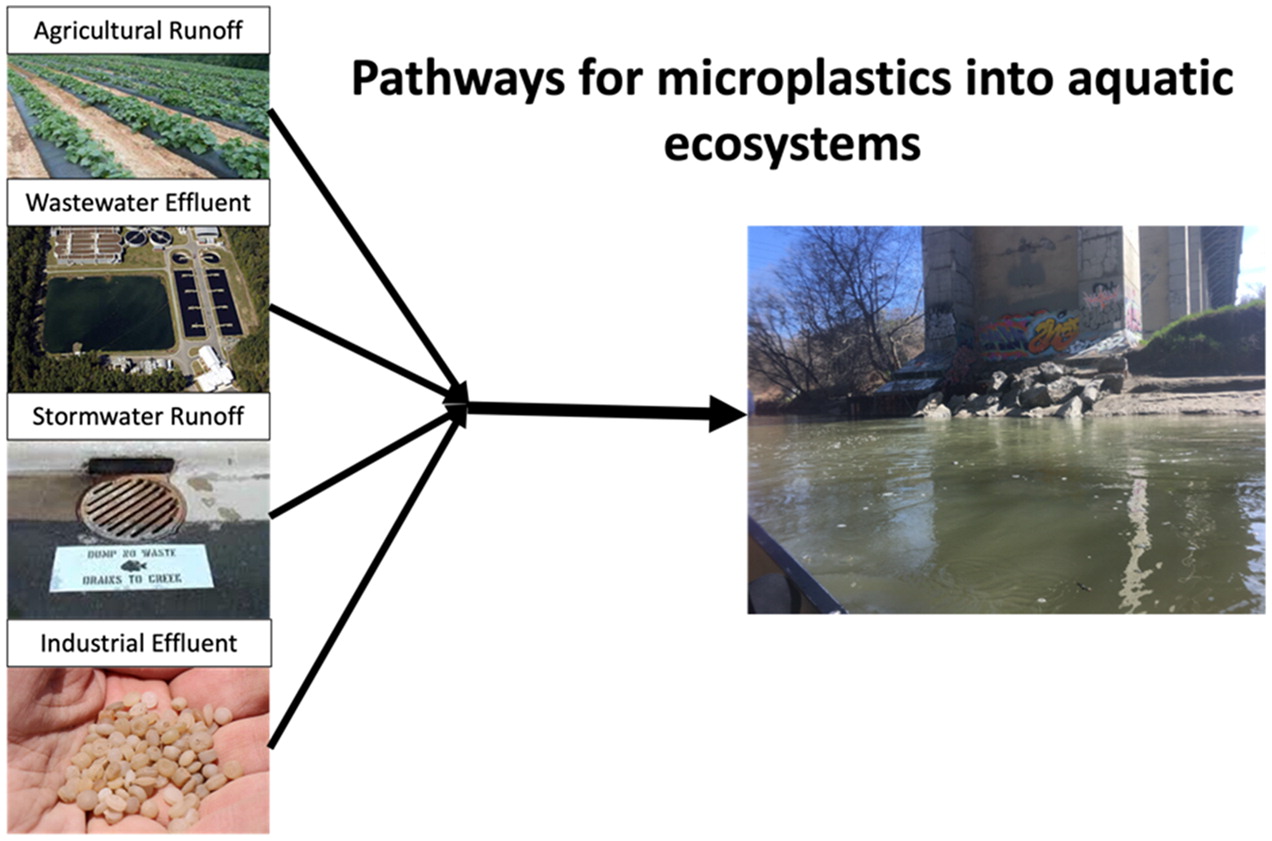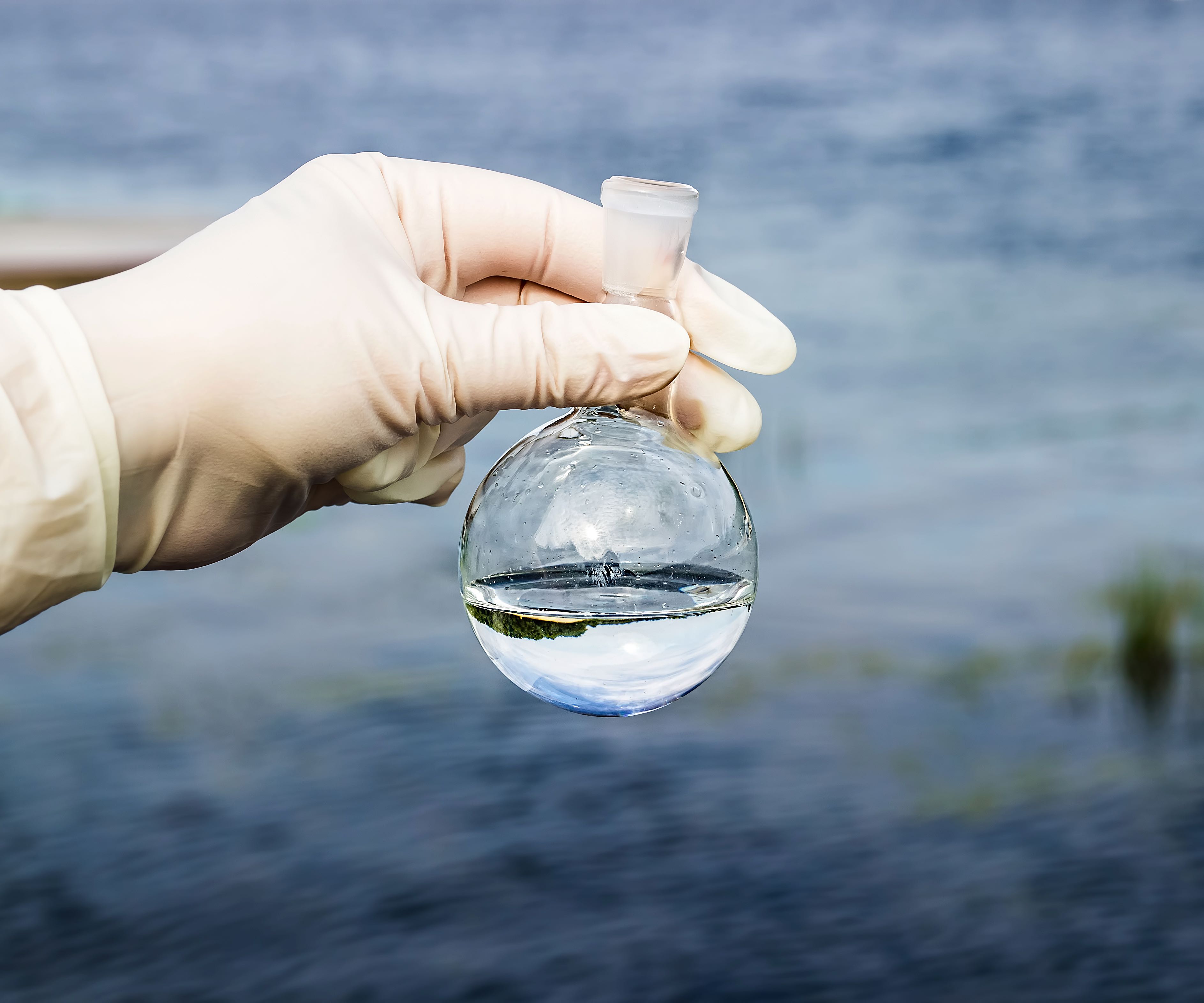Abstract
Although many studies have focused on the importance of littering and (or) illegal dumping as a source of plastic pollution to freshwater, other relevant pathways should be considered, including wastewater, stormwater runoff, industrial effluent/runoff, and agricultural runoff. Here, we conducted a meta-analysis focused on these four pathways. We quantified the number of studies, amount and characteristics of microplastics reported, and the methods used to sample and measure microplastics from each pathway. Overall, we found 121 studies relevant to our criteria, published from 2014 to 2020. Of these, 54 (45%) quantified and characterized microplastics in discharge pathways. Although most focused on wastewater treatment plant effluent (85%), microplastic concentrations were highest in stormwater runoff (0.009 to 3862 particles/L). Morphologies of particles varied among pathways and sampling methods. For example, stormwater runoff was the only pathway with rubbery particles. When assessing methods, our analysis suggested that water filtered through a finer (<200 um) mesh and of a smaller volume (e.g., 6 L) captured more particles, and with a slightly greater morphological diversity. Overall, our meta-analysis suggested that all four pathways bring microplastics into freshwater ecosystems, and further research is necessary to inform the best methods for monitoring and to better understand hydrologic patterns that can inform local mitigation.
Graphical Abstract

Introduction
Researchers estimated that 24–34 million metric tons of plastic waste entered aquatic ecosystems in 2020 (Borrelle et al. 2020). Global estimates of plastic often consider mismanaged waste (i.e., littering from municipal solid waste) as the primary source (Jambeck et al. 2015). While the littering of mismanaged waste is one pathway of plastic pollution, other sources and pathways into the environment also need to be measured. Other key pathways separate from littering include fishing (Macfadyen et al. 2009), agricultural runoff (Nizzetto et al. 2016; Liu et al. 2018; Lv et al. 2019), stormwater runoff (Liu et al. 2019a; Liu et al. 2019b; Grbić et al. 2020), and wastewater treatment plant effluent (Magnusson and Norén 2014; Mason et al. 2016; Murphy et al. 2016; Carr et al. 2016). Some of these pathways are particularly relevant for microplastics (particles smaller than 5 mm in size; Thompson et al. 2009). Although there are many sources of microplastics into aquatic systems, the abundance and composition of microplastics among different pathways is rarely compared (Horton et al. 2017; Lv et al. 2019; Grbić et al. 2020; Hoellein and Rochman 2021).
Microplastics are reported to be the most abundant plastic debris by count in aquatic ecosystems (van Sebille et al. 2015). Microplastics have primary and secondary sources. Primary microplastics are manufactured as small pieces of plastics (e.g., pre-production pellets and microbeads in rinse-off personal care products; Cauwenberghe et al. 2015; Laskar and Kumar 2019). Secondary microplastics are degraded pieces of larger plastics, broken down via photo-, mechanical- or bio-degradation (Arthur et al. 2009; Laskar and Kumar 2019), including fragmentation of plastic litter, and microparticles from the wear of products during use (e.g., tire particles, microfibers from textiles, and films used in agriculture).
Like all plastic debris, microplastics are persistent (Worm et al. 2017) and ubiquitous (Rochman and Hoellein 2020). Microplastics are common in freshwater (Horton et al. 2017; Hoellein et al. 2019; Allen et al. 2019), the atmosphere (Brahney et al. 2020), seafood (Abbasi et al. 2018; Van Cauwenberghe and Janssen 2014; Davidson and Dudas 2016), and move through ecosystems as recalcitrant particulate carbon (Zhu et al. 2021). They are also found at every level of aquatic food webs, with potential implications for predators when they move up the food chain (Provencher et al. 2019). Humans may also be exposed via water resource use (e.g., fish consumption, drinking water, food crop irrigation) in addition to inhalation (Wright and Kelly 2017; Danopoulos et al. 2020). Consequently, additional measurements of the sources and transport pathways of microplastics into the environment are needed to inform mitigation.
Transport pathways for microplastics to aquatic ecosystems include stormwater runoff (Liu et al. 2019a; Liu et al. 2019b; Grbić et al. 2020), wastewater treatment plant (WWTP) effluent (Magnusson and Norén 2014; Mason et al. 2016; Murphy et al. 2016; Carr et al. 2016), industrial effluent/runoff (Li et al. 2020; Deng et al. 2020), agricultural runoff (Ng et al. 2018; Lv et al. 2019), and atmospheric deposition (Brahney et al. 2020). Stormwater runoff is precipitation that carries sediments, chemicals, and anthropogenic particles, including microplastics, from impervious surface or land into aquatic ecosystems. WWTP effluent is treated sewage and has been identified as a contributor of microplastics to aquatic ecosystems globally (Magnusson and Norén 2014; Mason et al. 2016), including in North America (Carr et al. 2016; Mason et al. 2016; Hoellein et al. 2017), Europe (Magnusson and Norén 2014; Murphy et al. 2016), Australia (Ziajahromi et al. 2017), and Asia (Li et al. 2020; Lv et al. 2019). Industrial effluent/runoff is treated or untreated waste from any industry that is either released directly to aquatic ecosystems via runoff or treated beforehand. The importance of industrial effluent/runoff as a pathway for microplastics has only recently been explored (Deng et al. 2020; Lechner and Ramler 2015; Li et al. 2020). Agricultural runoff is excess water draining from agricultural fields after irrigation or precipitation. Agriculture-derived microplastics come from sources such as plastic mulch and the use of sludge-based fertilizers (Horton et al. 2017). Previous studies extrapolated a total annual input of 63–430 thousand metric tons of microplastics to farmlands in Europe and up to 300 thousand tons of microplastics to the farmlands in North America, which have the potential to enter aquatic ecosystems through runoff (Nizzetto et al. 2016). Atmospheric deposition of microplastics is also recognized as a pathway for the redistribution of microplastics (Allen et al. 2019; Wright et al. 2020), but few studies have attempted to quantify contributions to aquatic ecosystems and it may be low relative to other pathways (e.g., 0.03 tons per year estimated by Boucher et al. 2019). While multiple pathways transfer microplastics into aquatic ecosystems, the relative abundance and composition of microplastics is rarely quantified across pathways.
Here, we conducted a systematic review and meta-analysis to synthesize research on microplastic pollution contributed by stormwater runoff, WWTP effluent, industrial effluent/runoff, and agricultural runoff. We did not include atmospheric transport because it is less relevant to informing mitigation strategies. Our objectives were (1) examine the progression of research on microplastics in each of four management-relevant pathways over time, (2) assess the relative concentrations and composition (i.e., morphology) of microplastic in each, and (3) assess the methods employed for studying microplastic concentration and morphologies across pathways. Results from this analysis will inform future research priorities on microplastic dynamics in aquatic ecosystems, thereby supporting the prevention and mitigation of plastic pollution globally.


